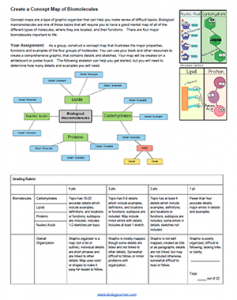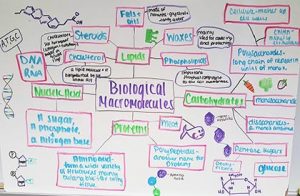
This activity asks students to work in groups to create a concept map (graphic organizer) on the biological macromolecules: carbohydrates, lipids, fats, and nucleic acids. Students are given brief instructions and a sample map to get them started, but they are responsible for determining what details are important in each section.
This activity is intended for use after a short lecture and introduction on the topic. Students either view Google slides on Biological Macromolecules or watch the Amoeba Sisters video or Crash Course. I often use a combination of these as in-class work and homework and encourage students to use resources in their textbook (Chapter 3, Openstax Biology)
The instructions are sparse to give students room to create an organize their graphic and work together. A rubric is included, mainly based on the number of details included under each category and overall organization and creativity.
Students are expected to have at least one sketch per group, but encouraged to represent ideas in pictures also. An alternative to this assignment and a more individualized activity is for students to choose one group and create Macromolecule Sketchnotes.
Most of my students are familiar with graphic organizers, but occasionally have groups that struggle getting started. In those cases, I suggest that each main category will have four main details.
What it’s composed of, where it’s found, what it looks like, and what it is used for. That can usually help get them started, but stress that some groups might have more details than others, for example, carbohydrates have multiple functions in living systems.

Grade Level: 9-12
Time Required: 45-65 minutes (1-2 class periods)

HS-LS1-2 Develop and use a model to illustrate the hierarchical organization of interacting systems that provide specific functions within multicellular organisms.
HS-LS1-6 Construct and revise an explanation based on evidence for how carbon, hydrogen, and oxygen from sugar molecules may combine with other elements to form amino acids and/or other large carbon-based molecules.

